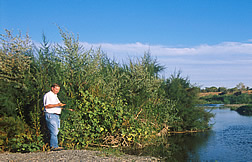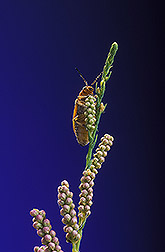This page has been archived and is being provided for reference purposes only. The page is no longer being updated, and therefore, links on the page may be invalid.
|
Read the magazine story to find out more. |
|
|
Beneficial Beetles Battle Pesky Saltcedar
By Marcia WoodApril 1, 2005
Tiny beetles that munch on saltcedar leaves, shoots and twig bark are helping stop the spread of this rugged, aggressive weed. Also known as tamarisk, saltcedar was brought into the United States in the 1800s to help control erosion. By the mid-1900s, however, saltcedar had become an out-of-control pest, crowding native plants, such as cottonwoods and willows, along streambanks and river channels throughout the American West.
Agricultural Research Service (ARS) entomologist C. Jack DeLoach, ARS ecologist Raymond I. Carruthers, and their co-investigators have found that a leafbeetle that they've investigated and helped import, Diorhabda elongata, has now defoliated hundreds of acres of saltcedar-infested test sites in Colorado, Nevada, Utah and Wyoming. Yet the beetle poses no hazard to people, pets or crops.
DeLoach is with the ARS Grassland Protection Research Unit at Temple, Texas. Carruthers is based at the ARS Western Regional Research Center in Albany, Calif.
The outdoor tests, begun in 2001, represent the first time any natural organism had been lined up to tackle tamarisk. Collected from saltcedar in the Mediterranean region as well as in China, Kazakhstan, and other parts of Asia--all lands where the troublesome tree is native--the beetles devour saltcedar's scale-like leaves. That happens when the insect is in its caterpillar-like larval stage or has matured into a quarter-inch-long adult beetle.
Besides disrupting the natural surroundings needed by native plants, birds, fish and other forms of life, saltcedar plays havoc with farm roads and fields. For example, when rivers and streams overflow their banks, saltcedar bushes can trap natural flood debris, blocking waterflow and causing new, erosive channels to form. These channels sometimes undercut farm roads and fields, causing them to collapse.
What's more, river rafters or thirsty wildlife and livestock often can't get through dense thickets of saltcedar bushes or stands of pink-blossomed trees.
Read more in the April issue of the Agricultural Research magazine.
ARS is the U.S. Department of Agriculture's chief scientific research agency.


